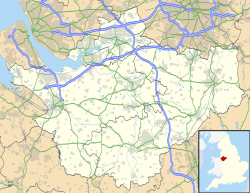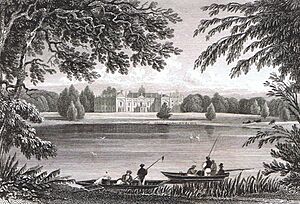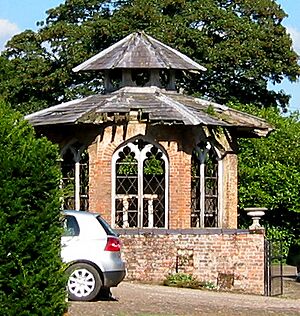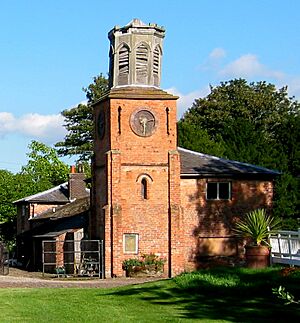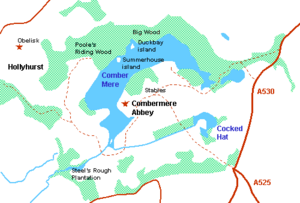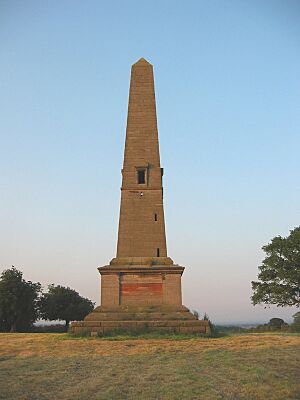Combermere Abbey facts for kids

Abbot's house and clock tower
|
|
| Monastery information | |
|---|---|
| Order | Savigniac, Cistercian |
| Established | ~1130 |
| Disestablished | 1538 |
| Dedicated to | Virgin Mary and St Michael |
| Controlled churches | Acton, Baddiley, Church Coppenhall, Church Minshull, Nantwich, Wrenbury, Sandon, Alstonfield, Child's Ercall |
| People | |
| Founder(s) | Hugh Malbank, 2nd Baron of Wich Malbank |
| Important associated figures | William Malbank, 3rd Baron of Wich Malbank, Ranulf de Gernon, 4th Earl of Chester, Ranulf de Blondeville, 6th Earl of Chester |
| Site | |
| Location | Dodcott cum Wilkesley, Cheshire, England |
| Coordinates | 52°59′37″N 2°36′50″W / 52.99361°N 2.61389°W |
| Visible remains | Abbot's house |
| Public access | Occasional |
Combermere Abbey is a historic place in Cheshire, England. It started as a monastery (a home for monks) around 1130. Later, it became a large country house. It is located near Burleydam, between Nantwich and Whitchurch.
The abbey was founded by Hugh Malbank, a powerful baron. It was first part of the Savigniac order, then became Cistercian. For a while, it was very successful. However, by 1275, it was in serious debt. It often came under royal control because of its money troubles.
Combermere Abbey was known for its poor discipline and arguments. It was the third largest monastery in Cheshire based on its income in 1535. In 1538, the abbey was closed down during the Dissolution of the Monasteries.
After it closed, Sir George Cotton bought the property. He tore down the church and most of the old buildings. He turned part of the abbey into a country house. The house was changed and updated many times over the centuries. It stayed with the Cotton family until 1919. Today, it is still a private home.
Combermere Abbey is a "Grade I listed building," meaning it's very important. It is also on the "Heritage at Risk" list. This means parts of it, like the north wing, are in danger of collapsing. The estate includes a large lake called Comber Mere. This lake is a "Site of Special Scientific Interest" because of its nature.
Contents
What's in a Name?
The name Combermere means "lake of the Cumbri." Cumbri is an old Welsh word for Wales. This name suggests that some native Welsh people lived in this area even after the Anglo-Saxons arrived.
History of the Abbey
How Combermere Abbey Started
Combermere Abbey was one of the first big Cistercian abbeys in Cheshire. It was dedicated to the Virgin Mary and Saint Michael. It began as a Savigniac monastery, but this order joined the Cistercians by 1147.
Hugh Malbank, the Baron of Nantwich, founded the abbey. He made the first land donation in the early 12th century. This was confirmed in 1130 by Ranulf de Gernons, the Earl of Chester. Building probably started around 1133.
The monks chose a peaceful, isolated spot for the abbey. It was a wooded area next to the large Comber Mere lake. This quiet location was perfect for the strict Savigniac monks. We don't know much about the first abbey buildings. The first abbot was named William.
Early Gifts and Growth
The abbey's founding document still exists. It shows that the abbey received a lot of land. This included the manor of Wilkesley and villages like Dodcott. They also got land at Burleydam, a mill, and a fishery.
A quarter of Nantwich was given to the abbey. Nantwich was a major salt producer. The abbey also received churches in Acton and Nantwich. Later, they got more churches in Staffordshire and Shropshire. Many other people gave land to the abbey in the 12th and 13th centuries.
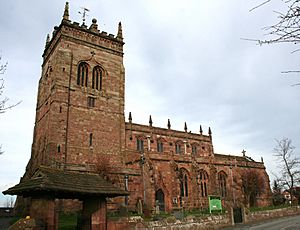
Most of the abbey's early records are lost. But for its first 100 years, Combermere seemed to do well. Around 1146–53, Abbot William helped found a new monastery called Poulton. This daughter house later moved and became Dieulacres Abbey.
Combermere also founded other daughter houses. Stanlow Abbey was started in 1178. In 1219, a small house was founded at Hulton. In 1245, the king visited Combermere. The abbey was then allowed to hold a market and fair at what is now Market Drayton.
The abbey also set up "granges" (farm estates). These were at places like Acton and Burland. By the late 13th century, they had many granges. Combermere started farming sheep earlier than other monasteries in Cheshire. They produced wool, which they sold at fairs and even exported.
Challenges and Decline

Around the mid-13th century, the abbey began to struggle. It faced many money problems and scandals. By 1275, its debts were so high that its management was taken over by others. The king even put it under royal protection for two years.
King Edward I's war against Wales in 1282–83 added more stress. The abbey ran low on food. Its financial problems continued through the 14th and 15th centuries. In 1496, it was even excused from paying taxes because it was so poor.
Historians aren't sure why the abbey got into so much debt. Some think its location near a busy road was a problem. It cost a lot to provide hospitality to guests. In 1328, the monks blamed earlier abbots for bad money management. They said abbots had leased out land too cheaply.
The abbots and monks often had fights with people outside the abbey. In 1281, a dispute with a French abbey led to some monks being kicked out of the church. In 1309, a man named Richard of Fullshurst attacked the abbey. He murdered the prior (a monk in charge), burned buildings, and stole goods.

These attacks happened again in 1344. In 1365, Combermere even took over its daughter house at Whalley. There were also conflicts with tenants in the 15th century. The worst was in 1446, when Abbot Richard Alderwas was murdered by a laborer.
The Black Death in 1348–49 likely affected Combermere. By 1379, there were only nine monks plus the abbot. Discipline seemed to break down. The abbey got a bad reputation. In 1414, Abbot William Plymouth was accused of making fake gold coins.
There were also power struggles inside the abbey. In 1520, a monk was murdered by a servant. The prior was accused of covering it up because of the abbey's "evil name."
Just before it closed, Combermere briefly produced salt. But the local salt industry complained, and it stopped.
The Abbey Closes Down
In 1535, the abbey's income was about £258. After expenses, its net income was £225. This made it the third richest monastery in Cheshire.
In February 1536, King Henry VIII's officials visited Combermere. They found the abbey had debts of £160. Like other abbeys, Combermere leased out many properties in its last few years.
The last abbot, John Massey, didn't fight the closure much. The abbey was officially closed on July 27, 1538. At that time, it had twelve monks plus the abbot. It owned a huge amount of land across several counties. Abbot Massey and the monks all received pensions.
In August 1539, Sir George Cotton and his wife, Mary, were given the abbey and its lands. The site still had a church with a bell-tower and a cemetery.
History of the Country House
From Abbey to Country Home (16th–18th Centuries)
After the abbey closed, the church and many monastery buildings were torn down. A building from the west side, thought to be the Abbot's House, was turned into a country house for the Cotton family. The Great Hall's roof timbers have been dated to 1502. This confirms that an old monastic building was used.
Sir George's son, Richard Cotton, redesigned the house in 1563. A stone tablet found in 1795 remembers his work. It says:
-
- Master Richard Cotton and his sons three
- Both for their pleasure and commoditie
- This building did edifie
- In fifteen hundred and sixty three
A poem from 1586 describes the abbey as a beehive. It praises the house and its lands. Richard Cotton's changes included hiding the old roof with a plaster ceiling. He also added a fireplace.
King William III stayed at the house in 1690. This visit might have led to some changes inside. The room where he supposedly slept is called the Orange Bedroom. There's also evidence of building work around 1725.
We know about the house from two 18th-century pictures. An engraving from 1727 shows the east side. An oil painting from around 1730 shows the house and gardens from above. The house had stone on the ground floor and timber framing above.
The famous writer Samuel Johnson visited the abbey in 1774. He described the house as "spacious, but not magnificent." He noted it was built at different times with different materials.
Sir Robert Salusbury Cotton moved to Combermere Abbey in 1773. He remodeled and extended the abbey around 1795.
Stapleton Cotton's Changes

The house's current look is mostly due to Sir Stapleton Cotton. He was a military hero during the Napoleonic Wars. He was given a special title and a yearly payment.
Between 1814 and 1821, he changed the house to look like a Gothic castle. He added fake battlements and pointed arches around the windows. He also built a large new wing for servants. Another wing, called Wellington's Wing, was built for the Duke of Wellington's visit in 1820.
He also redesigned the library inside. One visitor in 1821 said the house was "recently coated and ornamented in the pointed Gothic style."
Later, the first viscount planned more changes. But these were never built. However, some service buildings and the stable block were designed by famous architects. In 1854, a long entrance hall was added.
Later Years and Restoration
His son, Wellington Stapleton-Cotton, 2nd Viscount Combermere, did some more work in the 1870s. But the family's money problems grew worse. The second Viscount rented the abbey twice to Empress Elisabeth of Austria. She was a keen hunter. Many changes were made for her stays, including hot water and electric bells.
The second viscount died in 1891. A famous photo called "Lord Combermere's Ghost Photo" was taken in the library during his funeral. It seems to show his ghost sitting in a chair.
The next viscount, Robert Stapleton-Cotton, spent a lot of money. He tried to sell the estate in 1893, but couldn't. Katherine, Duchess of Westminster leased the abbey from 1898–1917.
In 1919, the abbey was sold to Sir Kenneth Crossley. He was an aircraft fan and flew his plane from the estate. During World War II, the house was used as a hospital and school. The local Home Guard also trained in the park.
Sir Kenneth's granddaughter, Penelope Callander, inherited the estate in 1957.
Modern Changes and Repairs
The 19th-century changes caused problems like dry rot. By the 1970s, the house was in bad shape. Some parts of the house were demolished in 1975 to fix issues.
The current owner, Sarah Callander Beckett, took over in 1992. In 1998, Combermere Abbey was put on the "Heritage at Risk" register. This means it needs urgent repairs.
Restoration work started in 2010. It focused on the library. As of 2013, the empty north wing is in "very bad" condition. Experts fear it could fall down. Repairing it is estimated to cost £2 million.
Attempts to build houses on the estate to fund repairs have faced opposition. However, a plan to build 43 houses was approved in 2013.
Many of the abbey's old outbuildings were falling apart. The stables were restored and turned into holiday cottages. The game larder and clock tower were also restored.
What Combermere Abbey Looks Like
Not much is left of the original monastery buildings. However, some medieval stonework is hidden inside the house. The current house is believed to be the Abbot's House. It has a timber frame and a rare, beautiful roof called a "false hammerbeam roof." This roof is decorated with coats of arms and carvings.
From a distance, Combermere looks like a romantic castle with battlements. Most of the outside is covered in grey cement. The windows have pointed arches. The roofs are made of slate.
The east side (where the entrance is) has three floors. It has a projecting porch with the Cotton family's coat of arms. The north wing, which was once Wellington's Wing, has been demolished. In some places, the timber frame is visible, showing old decorative patterns.
The west side (facing the lake) has eight sections. It has projecting wings at each end. This side has a Gothic-style porch.
Inside the House
On the ground floor, the main room was once the entrance hall. It is now a narrow dining room. Its features are from the early 19th century. The room has columns decorated with lilies and leaves.
Originally the Great Hall, the library on the first floor is the main reception room. It has a "magnificent" carved wooden screen. This screen probably dates from the early 17th century. It has carved figures and painted panels.
The carved wood above the fireplace includes portraits, like one of Henry VIII. The old hammerbeam roof in the library is hidden by a decorated plaster ceiling. This ceiling has painted coats of arms.
Other Buildings
The other buildings at the abbey are mostly from the 18th and 19th centuries. They are built of red brick and have Gothic decorations. A service court next to the house has two ranges of buildings. The north range has narrow windows and battlements. It includes a water tower.
The south range has a square clock tower, built in 1815 to celebrate the Battle of Waterloo. The clock is by JB Joyce & Co.
In the courtyard is a special building called a game larder. It's an octagonal structure with a wooden lantern on top. Inside, the original ironwork for hanging game meat is still there.
The stable block was designed in 1837. It forms a square around a courtyard. It has two cottages and a former carriage house. It features pointed windows and turrets. There's also a ruined icehouse nearby, from the 18th or 19th century.
Combermere Park
Park History
In the early 18th century, the abbey had large formal gardens. A painting from around 1730 shows the gardens with trees, ponds, and a long straight drive. A summer house was on Summerhouse Island.
The main entrance to the park was from the west. This area was later dug out to make the lake bigger. It's not known when the park was first designed. But by the 1790s, it had many old trees. Sir Robert Salusbury Cotton landscaped the park around 1795–97.
Park Features
The modern estate covers about 1,110 acres. It is mainly in Cheshire and extends into Shropshire. It is run as an organic dairy farm. About 990 acres of the park are listed as a "Historic Park and Garden."
The gardens include a 5-acre walled garden. A maze of fruit trees was created there in the 1990s.
Several buildings in the park are also listed. A sandstone sundial near the house might have parts of a 12th-century column from the abbey. Stone Lodge, an old gate lodge, is now a holiday cottage. It was built around 1828.
Brankelow Cottage is a charming building near Comber Mere. It was built as a model dairy. It was later used as a gamekeeper's cottage and is now a "folly" (a building built for decoration). It has battlements and fancy brickwork. A stone obelisk from 1890 remembers the first Viscount Combermere.
Comber Mere Lake
The park includes the natural lake of Comber Mere. It covers about 132 acres. It is the largest lake in a private English park.
A large area of the lake and its surroundings is a "Site of Special Scientific Interest" (SSSI). This is because of its swamp and fen environments. It is also important for birds. The lake is a key place for wildfowl (ducks, geese, swans) to spend the winter. It also has one of the largest heronries (heron nesting sites) in Cheshire.
Images for kids


